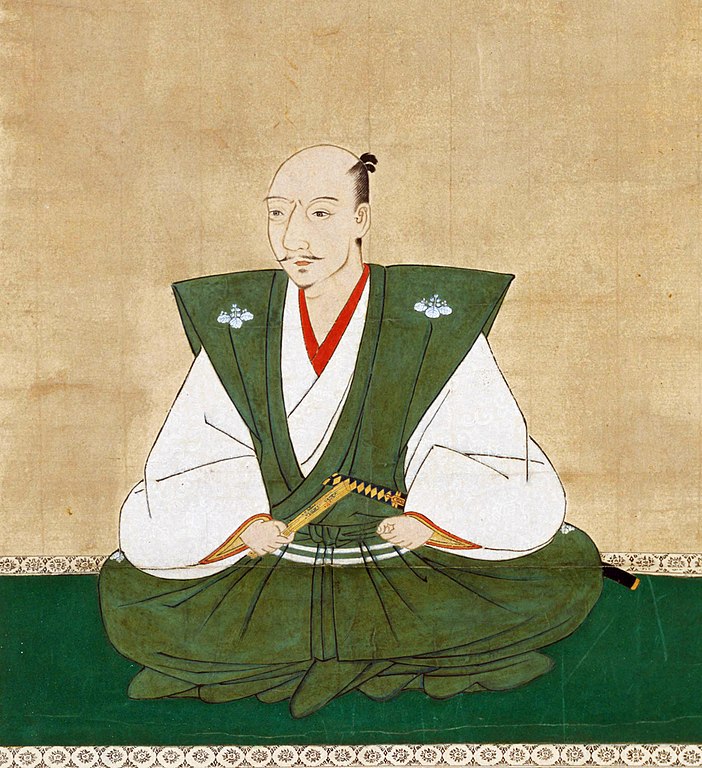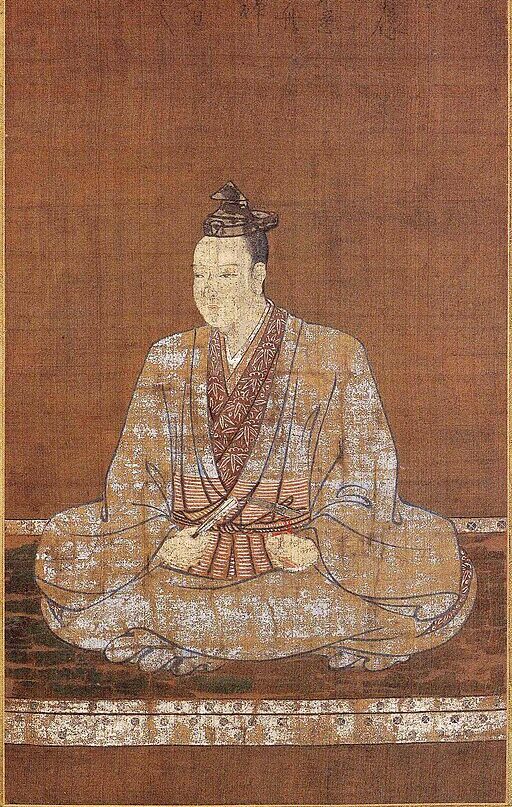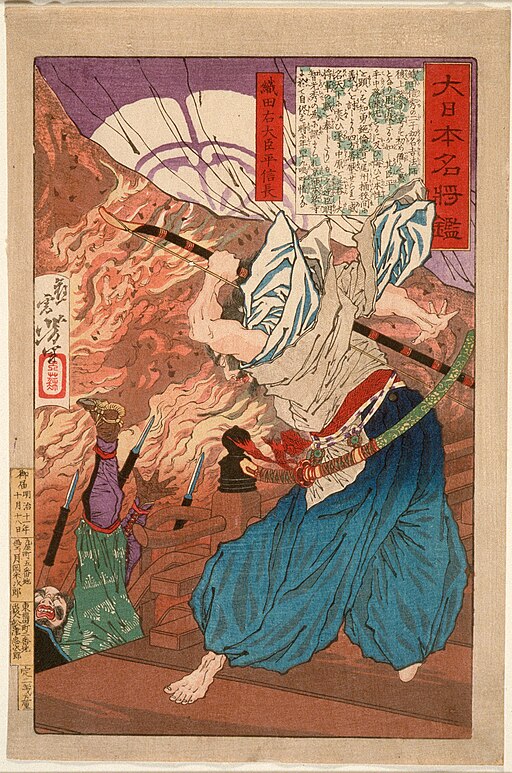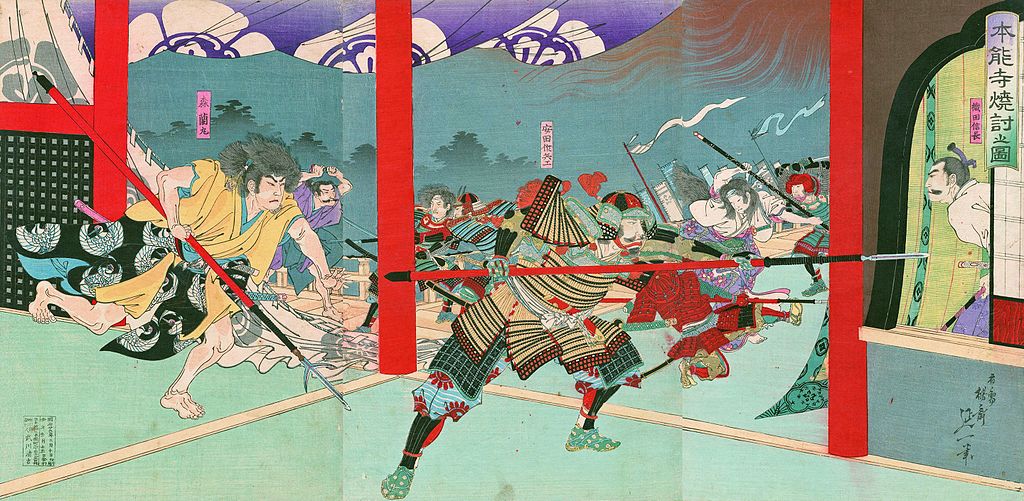Introduction
The Honnō-ji Incident is one of the most dramatic events in Japanese history. It took place on June 21, 1582, and marked a turning point in the Sengoku period. During this incident, Oda Nobunaga, one of Japan’s most powerful and ambitious warlords, was betrayed and forced to commit seppuku by one of his trusted generals, Akechi Mitsuhide.
Oda Nobunaga had been on a relentless campaign to unify Japan. His innovative tactics and ruthless strategies had brought him significant success. However, his rapid rise to power also created enemies and fostered deep-seated resentments among his allies.
Akechi Mitsuhide, a prominent samurai under Nobunaga’s command, played a crucial role in many of Nobunaga’s military victories. Despite his loyalty and contributions, Mitsuhide harbored grievances against Nobunaga. These tensions eventually led to his shocking betrayal at Honnō-ji.
In this blog post, we will delve into the historical context of the Sengoku period, explore the backgrounds of Nobunaga and Mitsuhide, and examine the sequence of events leading up to the Honnō-ji Incident. We will also discuss the possible reasons behind Mitsuhide’s betrayal and its far-reaching consequences. By the end, you will gain a deeper understanding of why Akechi Mitsuhide turned against Oda Nobunaga and how this betrayal shaped the course of Japanese history.
1. Historical Context
A. The Sengoku Period
The Sengoku period, also known as the Warring States period, was a time of intense military conflict and social upheaval in Japan. Spanning from the mid-15th century to the early 17th century, this era was characterized by the fragmentation of power among various daimyos, or feudal lords. Constant warfare and shifting alliances were the norms as these lords vied for control over different regions of Japan.
The central authority of the Ashikaga shogunate weakened significantly, leading to the rise of autonomous regional rulers. This power vacuum created a chaotic environment where only the strongest and most cunning leaders could thrive. Amid this turmoil, Oda Nobunaga emerged as a formidable force, known for his strategic brilliance and ruthless ambition.
B. Oda Nobunaga’s Rise to Power
Oda Nobunaga’s ascent to power began in the province of Owari, where he was born in 1534. He was initially considered an unlikely leader due to his unconventional behavior and appearance. However, Nobunaga quickly proved his mettle on the battlefield. He defeated rival clans and consolidated power within Owari, demonstrating his tactical genius.
Nobunaga’s most significant early victory was at the Battle of Okehazama in 1560, where he defeated the much larger army of Imagawa Yoshimoto. This victory not only solidified his control over Owari but also marked him as a rising power in the region. Nobunaga continued to expand his influence through a combination of military conquests and strategic alliances.
One of Nobunaga’s notable strategies was his use of innovative tactics and technology. He was among the first to effectively utilize firearms in battle, which gave his forces a significant advantage. Additionally, Nobunaga implemented reforms to streamline administration and promote economic growth, further strengthening his position.
As Nobunaga’s power grew, so did his vision for a unified Japan. He aimed to dismantle the traditional feudal structure and create a centralized state under his control. This ambition set him on a collision course with other powerful daimyos and the influential Buddhist monasteries that opposed his rule.
2. The Characters
A. Oda Nobunaga

Oda Nobunaga was a complex and dynamic leader. Born in 1534, he became the head of the Oda clan at a young age. Nobunaga was known for his boldness, strategic acumen, and willingness to adopt new technologies and methods. His leadership style was characterized by decisiveness and a relentless drive for power.
Nobunaga had a clear vision for a unified Japan. He sought to dismantle the feudal system and establish centralized control. This ambition made him both revered and feared. Nobunaga was innovative in warfare, notably using firearms effectively, which was uncommon at the time. His military campaigns were swift and brutal, leaving little room for opposition.
However, Nobunaga’s relationships with his retainers were often strained. His harsh treatment of those who failed him and his ruthless suppression of opposition created many enemies. Despite his formidable leadership, his disregard for traditional practices and his relentless pursuit of power alienated many, including some of his closest allies.
B. Akechi Mitsuhide

Akechi Mitsuhide was a prominent samurai and one of Nobunaga’s most trusted generals. Born in 1528, Mitsuhide hailed from a noble but financially strained family. He initially served under the Saito clan before joining Nobunaga. Mitsuhide’s intelligence and military prowess quickly earned him a significant role within Nobunaga’s administration.
Mitsuhide was known for his cultured demeanor and strategic mind. He was well-read, versed in both military tactics and classical literature. His service under Nobunaga included several critical assignments, where he demonstrated loyalty and competence. Despite his loyalty, Mitsuhide often found himself at odds with Nobunaga’s harsh methods.
Personal conflicts between Mitsuhide and Nobunaga escalated over time. Nobunaga’s public humiliations of Mitsuhide and the harsh treatment of his family deepened the rift. Additionally, Mitsuhide’s growing dissatisfaction with Nobunaga’s disregard for traditional values and his ruthless ambition further strained their relationship.
Mitsuhide’s decision to betray Nobunaga at Honnō-ji was influenced by a complex mix of personal grievances, political ambitions, and strategic considerations. His betrayal shocked many and left a lasting impact on Japanese history, highlighting the intricate dynamics of power and loyalty during the Sengoku period.
In summary, both Oda Nobunaga and Akechi Mitsuhide were influential figures with contrasting yet intertwined destinies. Nobunaga’s visionary but ruthless quest for power and Mitsuhide’s loyalty turned to resentment set the stage for the dramatic events at Honnō-ji. Their characters and actions are central to understanding the causes and consequences of this pivotal moment in Japanese history.
3. The Events Leading Up to the Incident
A. Nobunaga’s Campaigns
Oda Nobunaga’s military campaigns were crucial in his quest to unify Japan. By the late 1570s, he had already established himself as a dominant force. Nobunaga’s campaigns were marked by swift and decisive actions, often leveraging innovative tactics and technology. His use of firearms, strategic castle construction, and alliances with other powerful clans showcased his strategic brilliance.
One of Nobunaga’s significant campaigns was against the Takeda clan. The Battle of Nagashino in 1575 was a turning point, where Nobunaga’s forces decimated the Takeda cavalry using well-coordinated arquebusiers. This victory further solidified his reputation as an unbeatable military strategist.
As Nobunaga’s power grew, he targeted the Ikko-ikki, a group of militant Buddhist monks who resisted his authority. His relentless campaigns against these religious groups, including the siege of Ishiyama Hongan-ji, demonstrated his determination to eliminate any threats to his vision of a unified Japan.
By 1582, Nobunaga had successfully subdued or allied with most of the major daimyos. His next goal was to eliminate the last significant opposition in western Japan. Nobunaga sent his trusted general, Toyotomi Hideyoshi, to campaign against the Mori clan, one of the last powerful clans standing against him.
B. Mitsuhide’s Role in Nobunaga’s Administration
Akechi Mitsuhide played a crucial role in Nobunaga’s administration. He was a respected general known for his intelligence and strategic mind. Mitsuhide participated in many of Nobunaga’s significant campaigns, contributing to their success. His loyalty and competence earned him Nobunaga’s trust, and he was often given critical assignments.
Mitsuhide’s responsibilities included governing territories and leading military expeditions. He managed the provinces of Tamba and Sakamoto, where he implemented policies to stabilize and develop these regions. Despite his loyalty, Mitsuhide’s relationship with Nobunaga was not without tension.
Nobunaga’s harsh treatment of his retainers, including Mitsuhide, created underlying resentment. Nobunaga’s public humiliations of Mitsuhide, such as reprimanding him in front of other generals, fueled this discontent. Additionally, Mitsuhide’s family faced severe repercussions due to Nobunaga’s actions, further deepening the rift between them.
In the months leading up to the Honnō-ji Incident, Mitsuhide was tasked with critical missions. He supported Hideyoshi’s campaign against the Mori clan and managed strategic territories. However, the growing tension and dissatisfaction within Nobunaga’s ranks set the stage for the impending betrayal.
C. Growing Tensions and Conflicts
The relationship between Nobunaga and Mitsuhide deteriorated due to several key incidents. Nobunaga’s uncompromising and often brutal approach to governance and warfare alienated many of his retainers. Mitsuhide, who valued traditional samurai honor and loyalty, found Nobunaga’s methods increasingly intolerable.
One significant incident that fueled Mitsuhide’s resentment was the attack on the Mitsuhide family’s estates by Nobunaga’s forces. This attack resulted in the death of Mitsuhide’s mother, a tragic event that deeply embittered him. Nobunaga’s failure to recognize Mitsuhide’s sacrifices and contributions further strained their relationship.
Political pressures and power struggles within Nobunaga’s administration also contributed to the growing tensions. Mitsuhide, despite his loyalty, found himself marginalized and underappreciated. Nobunaga’s favoring of other generals, such as Hideyoshi, created a sense of rivalry and discontent.
As Nobunaga prepared to move westward to support Hideyoshi against the Mori clan, Mitsuhide saw an opportunity to act on his grievances. The combination of personal vendettas, political ambition, and strategic considerations led Mitsuhide to make a drastic decision that would alter the course of Japanese history.
The events leading up to the Honnō-ji Incident were marked by Nobunaga’s relentless campaigns for unification, Mitsuhide’s critical role and growing discontent, and escalating tensions within Nobunaga’s administration. These factors set the stage for Mitsuhide’s betrayal, a pivotal moment that would have far-reaching consequences.
4. The Honnō-ji Incident
A. The Setting
The Honnō-ji Temple, located in Kyoto, was a place of both religious significance and strategic importance. On June 21, 1582, Oda Nobunaga found himself at this temple, taking a brief respite from his relentless campaigns. Nobunaga was in Kyoto to prepare for further military actions and to meet with his generals. His stay at Honnō-ji was meant to be temporary, a short pause before continuing his conquest of Japan.
Kyoto, the imperial capital, was a vital location for Nobunaga’s political and military operations. By staying at Honnō-ji, Nobunaga was in a position to quickly respond to any developments in his campaign against the Mori clan in western Japan. His presence in the capital also signified his control and influence over the central regions of Japan.
B. The Betrayal
In the early hours of June 21, 1582, Akechi Mitsuhide launched a surprise attack on Honnō-ji Temple. Mitsuhide had mustered his forces under the pretense of joining Nobunaga’s campaign against the Mori clan. Instead, he directed his troops towards Kyoto with the explicit aim of overthrowing Nobunaga.
The attack on Honnō-ji was swift and brutal. Mitsuhide’s forces surrounded the temple, catching Nobunaga and his small retinue off guard. Nobunaga’s defenses were minimal, as he had not anticipated such a betrayal from one of his trusted generals. The temple was quickly set ablaze, and Nobunaga’s situation became dire.
Realizing the hopelessness of his position, Nobunaga chose to commit seppuku, the act of ritual suicide, rather than be captured by his enemies. This decision was in line with the samurai code of honor, which valued death over dishonor. Nobunaga’s loyal attendants followed suit, fighting to the death or committing seppuku alongside their lord.
Mitsuhide’s betrayal was complete, and Oda Nobunaga, one of Japan’s most powerful warlords, was dead. The news of Nobunaga’s death spread rapidly, causing shock and confusion throughout the land. Mitsuhide’s forces quickly took control of Kyoto, but his victory was far from secure.

C. Immediate Aftermath
The immediate aftermath of the Honnō-ji Incident was chaotic and tumultuous. Mitsuhide declared himself the ruler, hoping to consolidate power quickly. However, the unexpected nature of his betrayal left him with little support among Nobunaga’s former allies and retainers. Mitsuhide’s claim to power was contested by several factions, most notably by Toyotomi Hideyoshi, one of Nobunaga’s most trusted generals.
Hideyoshi, who was engaged in the campaign against the Mori clan, acted swiftly upon hearing the news of Nobunaga’s death. He secured a truce with the Mori clan and marched his forces back to Kyoto with remarkable speed. Within days, Hideyoshi confronted Mitsuhide’s forces at the Battle of Yamazaki.
The Battle of Yamazaki took place on July 2, 1582, just eleven days after the Honnō-ji Incident. Hideyoshi’s forces decisively defeated Mitsuhide’s troops, and Mitsuhide was forced to flee. While attempting to escape, Mitsuhide was killed by bandits or local peasants, marking the end of his short-lived rule.
D. Nobunaga’s Legacy
Despite his sudden and violent death, Oda Nobunaga’s legacy endured. His campaigns and reforms had significantly weakened the power of the traditional feudal lords and Buddhist institutions, paving the way for the unification of Japan. Nobunaga’s vision of a centralized state was eventually realized by his successors, Toyotomi Hideyoshi and Tokugawa Ieyasu.
Nobunaga’s innovative tactics and ruthless strategies left a lasting impact on Japanese military and political practices. His use of firearms, his strategic castle constructions, and his administrative reforms were all adopted and expanded upon by his successors. Nobunaga’s ambition and vision for a unified Japan set the stage for the eventual establishment of the Tokugawa shogunate, which would bring over two centuries of relative peace and stability to Japan.
In brief, the Honnō-ji Incident was a dramatic and pivotal moment in Japanese history. Akechi Mitsuhide’s betrayal and the death of Oda Nobunaga marked the end of one era and set the stage for the rise of Toyotomi Hideyoshi and the eventual unification of Japan. The events at Honnō-ji highlighted the complexities of loyalty, power, and ambition during the Sengoku period, leaving an indelible mark on the course of Japanese history.
5. Motivations Behind Mitsuhide’s Betrayal
A. Personal Grievances
Akechi Mitsuhide’s decision to betray Oda Nobunaga was driven, in part, by personal grievances. Mitsuhide had served Nobunaga loyally for many years, contributing significantly to his military campaigns. However, Nobunaga’s harsh and often humiliating treatment of his retainers created deep-seated resentment.
One of the most significant incidents fueling Mitsuhide’s anger was the attack on his family’s estates by Nobunaga’s forces. This attack resulted in the death of Mitsuhide’s mother, a tragic and deeply personal blow. Nobunaga’s failure to acknowledge or compensate for this loss further embittered Mitsuhide. The public humiliations Mitsuhide endured, such as being reprimanded in front of other generals, also played a crucial role in his growing discontent.
Mitsuhide’s personal honor and the samurai code emphasized loyalty and respect. Nobunaga’s disregard for these values, combined with his often tyrannical behavior, created a rift that personal loyalty alone could not bridge. These personal grievances were a significant factor in Mitsuhide’s decision to turn against his lord.
B. Political and Strategic Considerations
Mitsuhide’s betrayal was not solely motivated by personal grievances; political and strategic considerations also played a critical role. By 1582, Nobunaga had become immensely powerful, and his ambitions for unification threatened many established powers. Mitsuhide saw an opportunity to change the course of Japanese politics by removing Nobunaga from the scene.
Strategically, Mitsuhide may have believed that eliminating Nobunaga would allow him to gain control over the vast territories and resources Nobunaga had accumulated. As a general with significant military experience, Mitsuhide likely assessed that he could leverage Nobunaga’s death to rally other dissatisfied daimyos and consolidate power. His swift move to seize Kyoto after the attack on Honnō-ji indicates his ambition to establish himself as a new ruler.
Additionally, Mitsuhide may have perceived Nobunaga’s growing dominance as a threat to the traditional samurai order and the autonomy of regional lords. Nobunaga’s centralizing policies and ruthless suppression of opposition could have driven Mitsuhide to act in defense of the old feudal order and his own political future.
C. External Influences
The political landscape of the Sengoku period was complex, and external influences likely played a role in Mitsuhide’s decision. Other powerful daimyos and factions were undoubtedly watching Nobunaga’s rise with concern. Mitsuhide may have received encouragement or support from these factions, who saw Nobunaga’s elimination as beneficial to their interests.
The Ashikaga shogunate, though weakened, still held symbolic power. Mitsuhide, who had connections with the court, might have seen his betrayal as a way to restore some influence to the shogunate or gain favor with other political players. The possibility of alliances with rival clans who opposed Nobunaga’s dominance could have also influenced his decision.
Moreover, Mitsuhide’s betrayal can be seen as part of the broader power struggles that defined the Sengoku period. The constant shifting of alliances and rivalries created an environment where even trusted generals could be swayed by the prospect of greater power and influence. Mitsuhide’s actions reflect the opportunistic and turbulent nature of this era.
To summarize, Akechi Mitsuhide’s betrayal of Oda Nobunaga was driven by a combination of personal grievances, political and strategic ambitions, and external influences. His deep-seated resentment towards Nobunaga’s harsh treatment, coupled with his ambitions for power and potential encouragement from rival factions, led to the dramatic and pivotal Honnō-ji Incident. Understanding these motivations provides a clearer picture of the complex dynamics that shaped this critical moment in Japanese history.
6. Consequences and Impact
A. Immediate Aftermath
The immediate aftermath of the Honnō-ji Incident was one of chaos and rapid realignment of power. Akechi Mitsuhide’s initial success in assassinating Oda Nobunaga gave him control over Kyoto, but his position was precarious. The shock of Nobunaga’s death rippled through the country, causing confusion and alarm among Nobunaga’s allies and enemies alike.
Mitsuhide attempted to consolidate his power quickly by claiming leadership and trying to rally support from other daimyos. However, he faced significant challenges. Nobunaga’s death had left a power vacuum, and Mitsuhide’s betrayal did not sit well with many of Nobunaga’s former allies. His reign as the new ruler was short-lived.
Toyotomi Hideyoshi, one of Nobunaga’s most capable generals, acted swiftly upon hearing the news. He made a truce with the Mori clan and rapidly mobilized his forces to march towards Kyoto. Within days, Hideyoshi’s army confronted Mitsuhide’s forces at the Battle of Yamazaki on July 2, 1582. The battle was decisive; Hideyoshi’s forces overwhelmed Mitsuhide’s troops, leading to Mitsuhide’s defeat and subsequent death while fleeing.
B. Nobunaga’s Legacy
Despite his sudden demise, Oda Nobunaga’s legacy endured. His military campaigns and administrative reforms had fundamentally altered the political landscape of Japan. Nobunaga’s use of firearms, strategic castle building, and ruthless tactics had significantly weakened the traditional power structures, paving the way for the eventual unification of Japan.
Nobunaga’s vision of a centralized, unified state was carried forward by his successors. Toyotomi Hideyoshi, who emerged as the dominant figure after defeating Mitsuhide, continued Nobunaga’s work. Hideyoshi implemented further reforms and expanded his control, bringing most of Japan under his rule by the late 1580s.
Nobunaga’s innovations in warfare and governance left a lasting impact on Japanese society. His efforts to break the power of militant Buddhist sects and regional warlords created a more centralized and cohesive state. Nobunaga’s legacy was also marked by his promotion of trade and economic development, which laid the groundwork for future prosperity.
C. Long-term Impact on Japan
The long-term impact of the Honnō-ji Incident was profound. Nobunaga’s death and Mitsuhide’s brief usurpation set the stage for Toyotomi Hideyoshi’s rise to power. Following the incident, Hideyoshi’s subsequent campaigns and reforms further consolidated the unification of Japan, culminating in the establishment of the Tokugawa shogunate.
Hideyoshi’s rule was characterized by significant achievements, including land surveys, the establishment of a rigid class system, and policies that promoted agricultural and economic development. While his legacy was built on Nobunaga’s foundation, Hideyoshi also left his mark by successfully bringing an end to the Sengoku period.
The Tokugawa shogunate, established by Tokugawa Ieyasu after Hideyoshi’s death, continued the centralizing policies initiated by Nobunaga. The Tokugawa era ushered in over 250 years of relative peace and stability, known as the Edo period. This period saw the flourishing of Japanese culture, economy, and society, largely built on the foundations laid by Nobunaga’s initial efforts.
The Honnō-ji Incident also served as a cautionary tale about the fragility of power and the complexities of loyalty and betrayal in Japanese history. It highlighted the unpredictable nature of the Sengoku period, where personal ambitions and strategic calculations could dramatically alter the course of history.
It had immediate and long-term consequences that shaped the future of Japan. The rapid response and ultimate victory of Toyotomi Hideyoshi ensured the continuation of Nobunaga’s vision for a unified Japan. The incident underscored the turbulent and opportunistic nature of the Sengoku period, leaving an indelible mark on the nation’s history and setting the stage for the eventual peace and prosperity of the Edo period.
7. Historical Interpretations and Legacy
A. Differing Historical Perspectives
The Honnō-ji Incident has been the subject of extensive historical analysis and debate. Scholars have examined Akechi Mitsuhide’s betrayal from various angles, leading to differing interpretations of his motivations and the incident’s significance.
Some historians view Mitsuhide’s betrayal as primarily driven by personal grievances. Nobunaga’s harsh treatment of his retainers, particularly Mitsuhide, and the attack on Mitsuhide’s family are seen as key factors that fueled his resentment and led to his drastic actions. This perspective emphasizes the personal vendettas and emotional aspects of the betrayal.
Other scholars argue that Mitsuhide’s actions were influenced more by political and strategic considerations. From this viewpoint, Mitsuhide saw an opportunity to alter the power dynamics in Japan and possibly establish his rule. His swift move to seize Kyoto and attempt to consolidate power suggests a calculated decision aimed at capitalizing on the power vacuum created by Nobunaga’s death.
There are also interpretations that consider external influences and broader political contexts. Mitsuhide may have been influenced by other daimyos who were wary of Nobunaga’s growing power and ambitions. These external pressures and potential alliances could have played a role in Mitsuhide’s decision to act against Nobunaga.
Overall, the complexity of the Honnō-ji Incident allows for multiple interpretations, each highlighting different aspects of Mitsuhide’s motivations and the broader implications for Japanese history.
B. Cultural Depictions
The Honnō-ji Incident and its key figures have been depicted in various forms of Japanese culture, including literature, theater, film, and television. These cultural representations have contributed to the enduring legacy of the event and the characters involved.
In literature, the incident has been portrayed in historical novels and scholarly works, offering diverse perspectives on Mitsuhide’s betrayal and Nobunaga’s downfall. These literary works often explore the psychological and emotional dimensions of the characters, providing readers with a deeper understanding of their motivations and actions.
Traditional Japanese theater, such as Noh and Kabuki, has also dramatized the Honnō-ji Incident. These performances often emphasize the tragic and heroic elements of the story, portraying Mitsuhide as a complex figure torn between loyalty and ambition. The theatrical interpretations highlight the dramatic nature of the betrayal and its impact on the course of Japanese history.
In modern times, the Honnō-ji Incident has been depicted in numerous films and television dramas. These visual media portrayals have brought the story to a wider audience, often blending historical facts with creative storytelling. Characters like Oda Nobunaga and Akechi Mitsuhide are depicted with varying degrees of sympathy and villainy, reflecting the multifaceted nature of their historical roles.
C. Mitsuhide’s Legacy
Akechi Mitsuhide’s legacy is a subject of continued fascination and debate. While he is often remembered as the traitor who betrayed Nobunaga, his actions are also viewed in a more nuanced light by some historians and cultural depictions.
Mitsuhide’s brief rule after the Honnō-ji Incident is generally seen as a failure, given his quick defeat by Toyotomi Hideyoshi. However, his legacy is not solely defined by this failure. Mitsuhide’s actions had significant and lasting consequences, including the eventual rise of Hideyoshi and the continued unification of Japan.
In some interpretations, Mitsuhide is seen as a tragic figure, a capable and loyal retainer driven to betrayal by personal grievances and political necessity. This perspective portrays him as a complex individual caught in the turbulent dynamics of the Sengoku period.
Mitsuhide’s betrayal also serves as a reminder of the precariousness of power and the intricate web of loyalty, ambition, and strategy that characterized the era. His legacy, therefore, is intertwined with the broader themes of the Sengoku period, reflecting the volatile and often unpredictable nature of Japanese feudal politics.
D. Nobunaga’s Enduring Influence
Oda Nobunaga’s legacy, on the other hand, is marked by his role as a transformative figure in Japanese history. Despite his violent death, Nobunaga’s impact on Japan’s unification and modernization efforts is widely recognized and celebrated.
Nobunaga’s innovative military strategies, his use of firearms, and his administrative reforms laid the groundwork for the eventual unification of Japan. His vision of a centralized state influenced his successors, Toyotomi Hideyoshi and Tokugawa Ieyasu, who built upon his foundations to bring about a more unified and stable Japan.
Nobunaga’s ambition and ruthlessness are often highlighted in cultural depictions, portraying him as both a visionary leader and a feared warlord. His influence extends beyond his lifetime, shaping the course of Japanese history and leaving a lasting legacy that continues to be studied and remembered.
In essence, the historical interpretations and legacy of the Honnō-ji Incident and its key figures are complex and multifaceted. Mitsuhide’s betrayal, Nobunaga’s ambitious vision, and the subsequent rise of Hideyoshi all contribute to a rich tapestry of historical and cultural narratives that continue to captivate and intrigue scholars and the general public alike.
Conclusion
The Honnō-ji Incident stands as one of the most dramatic and pivotal events in Japanese history. The betrayal of Oda Nobunaga by Akechi Mitsuhide on June 21, 1582, marked a significant turning point in the Sengoku period, altering the course of the nation’s unification process.
Nobunaga’s relentless ambition and innovative strategies had brought him to the brink of unifying Japan. His harsh treatment of allies and enemies alike, however, sowed seeds of discontent, particularly with Mitsuhide. Mitsuhide’s betrayal was driven by a complex mix of personal grievances, political ambitions, and external influences. His actions at Honnō-ji, though briefly successful, led to his rapid downfall and the rise of Toyotomi Hideyoshi, who continued Nobunaga’s vision of a unified Japan.
The immediate aftermath of the incident saw rapid shifts in power, culminating in the Battle of Yamazaki and Mitsuhide’s death. Nobunaga’s legacy, however, endured. His reforms and military innovations had lasting impacts, paving the way for the eventual establishment of the Tokugawa shogunate, which brought an era of peace and stability to Japan.
Historians continue to debate the motivations behind Mitsuhide’s betrayal, offering various interpretations that highlight the personal, political, and strategic dimensions of the incident. Cultural depictions in literature, theater, and modern media have further cemented the event’s place in the collective memory of Japan, portraying the complexities of loyalty, power, and ambition.
In conclusion, the Honnō-ji Incident encapsulates the volatile nature of the Sengoku period and the intricate interplay of personal and political forces. It serves as a powerful reminder of the fragility of power and the far-reaching consequences of betrayal. The legacies of Oda Nobunaga and Akechi Mitsuhide continue to be studied and remembered, reflecting the enduring fascination with this critical moment in Japanese history.
References
- Berry, M. E. (1982). Hideyoshi. Harvard University Press.
- This book provides a comprehensive account of Toyotomi Hideyoshi’s life and his role in continuing Oda Nobunaga’s work after the Honnō-ji Incident.
- Elison, G., & Smith, B. L. (1987). Warlords, Artists, and Commoners: Japan in the Sixteenth Century. University of Hawaii Press.
- This work explores the cultural and political landscape of Japan during the Sengoku period, offering context for the Honnō-ji Incident.
- Lamers, J. (2000). Japonius Tyrannus: The Japanese Warlord Oda Nobunaga Reconsidered. Hotei Publishing.
- An in-depth biography of Oda Nobunaga, examining his military strategies, political ambitions, and the factors leading to his assassination.
- Sansom, G. B. (1961). A History of Japan: 1334-1615. Stanford University Press.
- A classic text that provides a detailed overview of Japanese history, including the Sengoku period and the events surrounding the Honnō-ji Incident.
- Turnbull, S. (2000). Samurai Warfare. Arms and Armour Press.
- This book discusses the military tactics and strategies used by samurai during the Sengoku period, with a focus on Oda Nobunaga’s innovative methods.
- Turnbull, S. (2003). War in Japan: 1467-1615. Osprey Publishing.
- A detailed account of the wars and conflicts during the Sengoku period, including the Honnō-ji Incident and its aftermath.
- Varley, H. P. (1971). The Ōnin War: History of Its Origins and Background with a Selective Translation of the Chronicle of Ōnin. Columbia University Press.
- Provides background on the conflicts that led to the Sengoku period, setting the stage for Nobunaga’s rise and eventual betrayal.
- Wikipedia Contributors. (2023). Honnō-ji Incident. Wikipedia, The Free Encyclopedia. Retrieved from https://en.wikipedia.org/wiki/Honn%C5%8D-ji_Incident
- A comprehensive overview of the Honnō-ji Incident, including details on the key figures, events, and historical interpretations.
These references offer a blend of scholarly works and accessible resources to provide a thorough understanding of the Honnō-ji Incident, the motivations behind Akechi Mitsuhide’s betrayal, and the broader historical context.

